Measuring Your Horse’s Stride
Lesson objective
To become familiar with your horse’s stride length and learn how to effectively collect (shorten) or extend (lengthen) your horse’s stride to find the path most suitable for your horse through lope-overs–thus, improving your overall trail class performance.

Lope-overs defined
An obstacle of at least four poles, measuring 6 to 7 feet (or in increments thereof) between poles, either on the ground or raised with a maximum center height of 10 inches. Poles can be in a straight line, curved or zigzag. (A curved or zig-zag design is measured for distance between the poles, from the center of the length of the pole to the center of the length of the next pole.)
Why you need this
Whether you’re competing in trail classes, reining, hunter under saddle or over fences, or just riding out on the trail, it’s important that you have an accurate feel of your horse’s stride length. Obviously, if you’re competing in a class that requires you to maneuver over or through obstacles (whether those are ground poles in trail or 3-foot-oxers in the jumper ring), knowing your horse’s stride will help you determine how to best navigate your horse to and over an obstacle. And, even if you’re not competing in trail or jumping classes, teaching your horse to lengthen and shorten his stride will improve your communication with him and encourage him to be more responsive to your cues.
How you’ll achieve this
We’re going to set up part of a trail course, consisting of two 12-foot boxes with a three-pole spoke in between (see the diagram below). We’ll begin by walking the course to give you a better understanding of how to ride it to appropriately match your horse’s stride. Next, we’ll set up two to three poles (as a warm up) at varying distances to help you determine your horse’s natural stride length. From there, we’ll progress to loping through the course on two different paths to find out what works best for your horse.
Why this works
These exercises, especially experimenting with two different paths through the course, will help you and your horse negotiate any set of lopeovers more easily and accurately. In essence, knowing your horse’s stride will be your most valuable tool for this lesson.
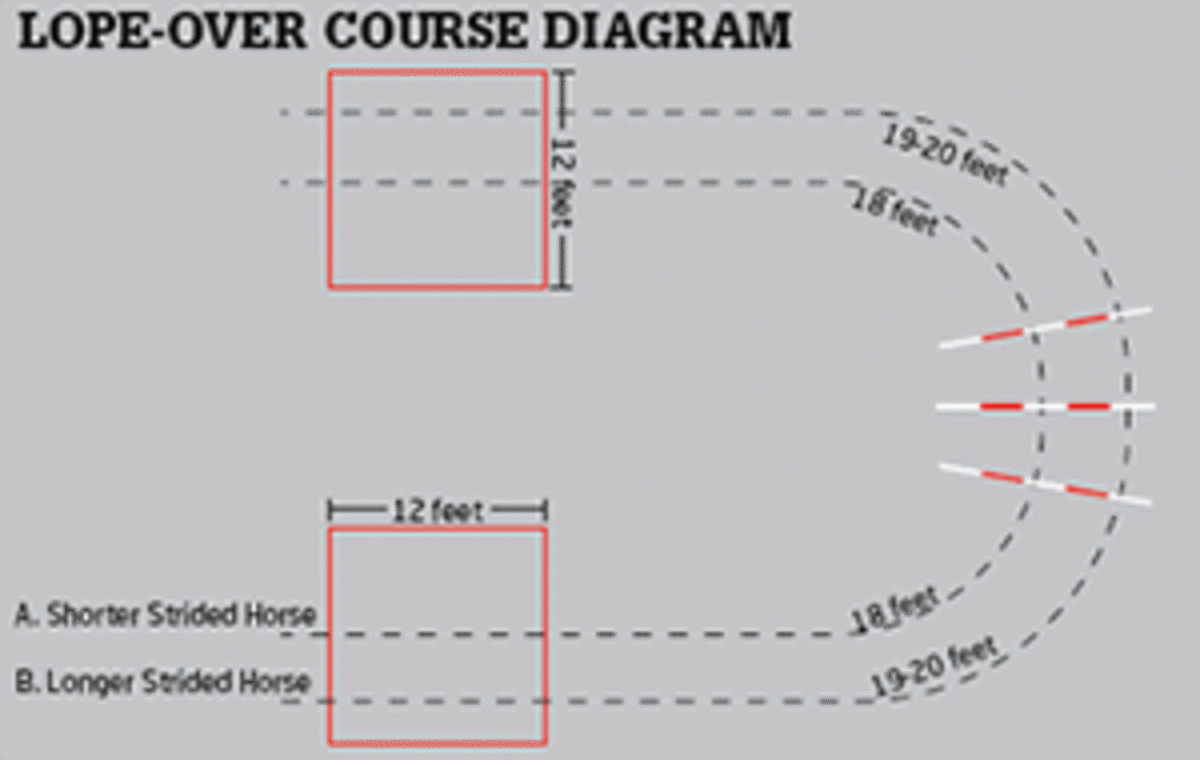
What you’ll need for this lesson:
- A fenced arena with soft, level footing is best, but if that’s not an option, you can set up the course in an open area if you have a quiet (not green) horse.
- Your schooling tack (i.e., saddle, pad and whatever bit you normally show in).
- 11 ground poles (If possible, try to use poles that are painted with alternating stripes. This will help you gauge your “path” easier.)
Skills your horse must have
This is not a lesson for a young or green horse. Your horse needs to be familiar with trail classes and know how to lope over poles. He should be willing and readily respond to your leg and rein aids; he should know how to lope collected, using his hindquarters without getting heavy on his forehand. (Any trail-class horse needs to know how to collect his stride.)
Caveat
As with any training, if you don’t feel confident in your horse’s (or your) capabilities, seek the help of a professional. This is an advanced lesson, so if your horse doesn’t have adequate knowledge and ability in negotiating trail course lope-overs, you’re not ready for this.
BEFORE YOU BEGIN:
“Carefully examine the diagram above. If you’re familiar with ‘walking’ distances between poles, you can count off your steps to determine the distances between poles. If you’re not confident in walking the distances, use a measuring tape. It’s important that you set up your course as accurately as possible to find your horse’s ideal path through the obstacles. As you’ll see in the diagram, make sure the three-pole spoke is centered between the two 12-foot boxes, so there are even distances between each side.”
Walkin’ the line: “Once you’re confident in the set-up of your course, carefully walk through it–first going through Path A (as shown in the diagram), then walking through Path B. For both paths, you’ll be working off of your left lead. Once you begin riding this course, you’ll follow Path A if you have a short-strided horse (I’ll help you determine your horse’s stride length later on in this lesson). If you have a long-strided horse, you’ll follow Path B.
“Walking the course from the ground is a good way for you to get a feel for your plan of action before doing it from the saddle. Hunter/jumper riders regularly walk their courses before riding them. This helps you see what path is most logical to take; how sharp or wide you need to make any turns; and, of course, determine distances between obstacles.”
1. DETERMINING YOUR HORSE’S NATURAL STRIDE
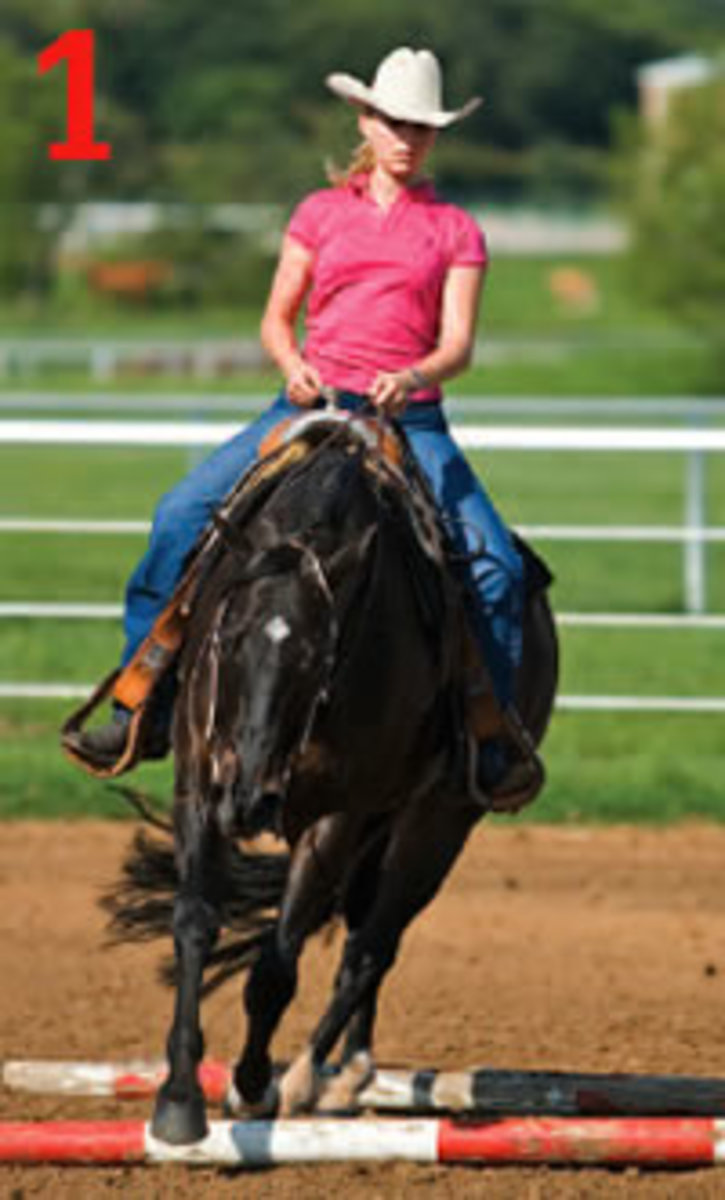
“Before you start navigating through the course, you need to determine your horse’s natural stride length. His natural stride is the length he averages while loping at a medium speed. Of course, you’ll want to teach him how to extend and shorten his stride, but for now, you want to figure out his ‘average-Joe’ speed. Horses are naturally going to have different stride lengths–a 14.3-hand Quarter Horse is going to have a smaller stride than a 17-hand Thoroughbred. The average horse stride is an estimated 12 feet, but you’ll find extremes in both directions and everything in between. We’re going to determine what stride length is natural for Zippy.
“Set up two or three ground poles on a straight line spaced six feet apart. Pick up a lope (it doesn’t matter which lead–just make sure you line Zippy up straight to the poles), and simply lope over them. Try to just ‘let it happen,’ rather than doing a lot with your body to manuever him over the poles. As you approach the line, look straight ahead, be soft with your upper body and allow Zippy to navigate his way over the poles. After riding through this several more times, assess how his stride felt. Did he seem to get ‘bottled up’ in between the poles? Or did he have to take a trot step to figure out where his legs should go next? Did his stride between poles feel unnaturally slow compared to his stride on the rail? If you answered ‘yes’ to any or all of these questions, then Zippy most likely is long-strided.
Try this next
“Next, you’re going to repeat the same exercise with the poles spaced seven feet apart. Again, lope through the poles on a straight line, looking ahead and not interfering with Zippy’s pace. After you’ve loped over these several times, ask yourself, ‘Did he feel like he was running over the poles? Did you feel like you were getting popped out of your saddle as he went over? Did he feel like he was making a tremendous effort to reach and get over?’ If you answered ‘yes’ to some or all of these, Zippy is probably short-strided. Now that we’ve determined Zippy’s natural stride length (he happens to be on the shorter side), we can progress to navigating the course.”
2A. & 2B. BOX #1
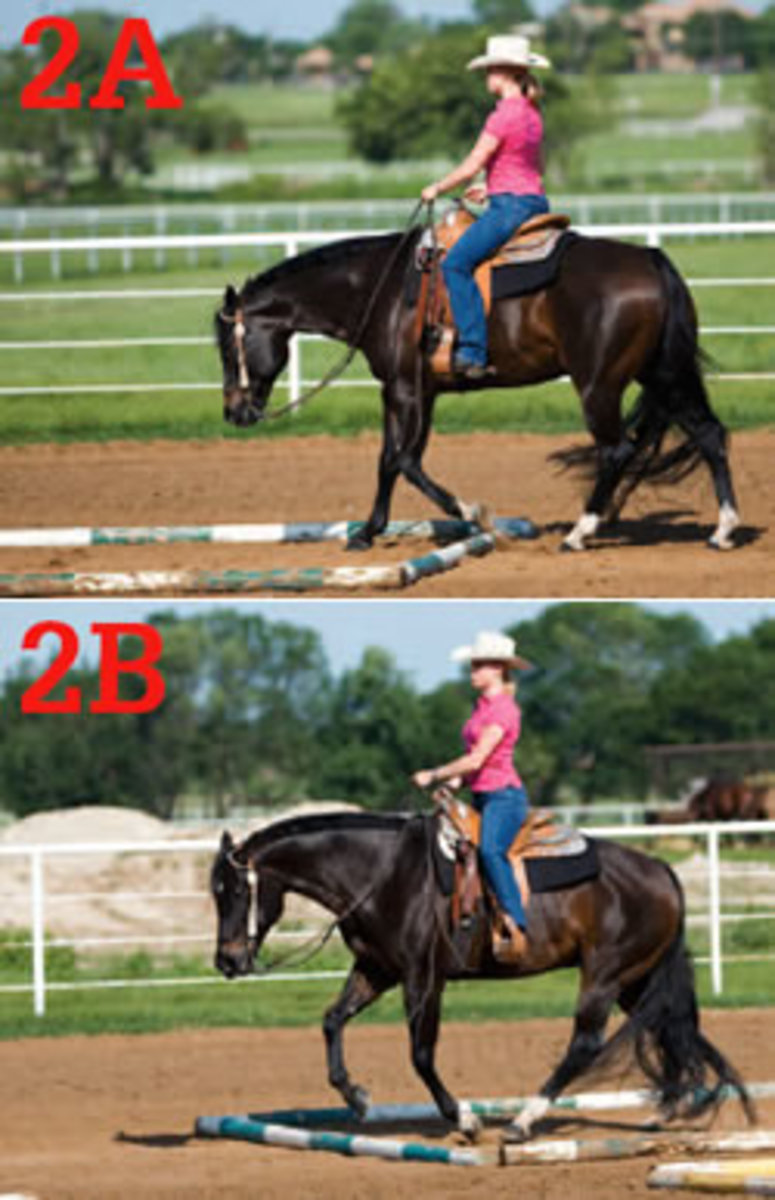
“As you’ll see from the photos, the first 12-foot box is composed of the green and white poles. Since, we’ve determined that Zippy has a smaller stride, you’re going to work on Path A first. This box is two strides, meaning Zippy will take one stride over the first pole and one stride out over the second pole.
“Pick up a left lead lope, starting far enough back to establish a consistent rhythm, and guide Zippy toward the center of the box (Path A). If your poles are divided by colors, you can aim for the color that’s center or slightly left of center. Like you practiced on the straight poles earlier, make sure you’re looking ahead (don’t stare down at the poles), keep your body centered in the middle of Zippy’s back, and allow him to move forward in his natural stride. Too often I see amateurs approach poles making
too much of an effort with their position and cues to maneuver their horse over them–which is counterproductive. Approach the poles like they’re just another lope stride. This will help you stay smooth and consistent.
“If you have a long-strided horse, you’ll approach the box the same way, but instead of following Path A, you’ll want to guide your horse along Path B. So, you’ll begin by aiming slightly to the right of center through your box. Taking this path will allow a smoother distance for a longer-strided horse, especially as you move past the first box to the spoke. If you have a horse with an extensively long stride, you’ll have to collect him and shorten his stride through the box to make for a smooth ride.”
3. THE THREE-POLE SPOKE
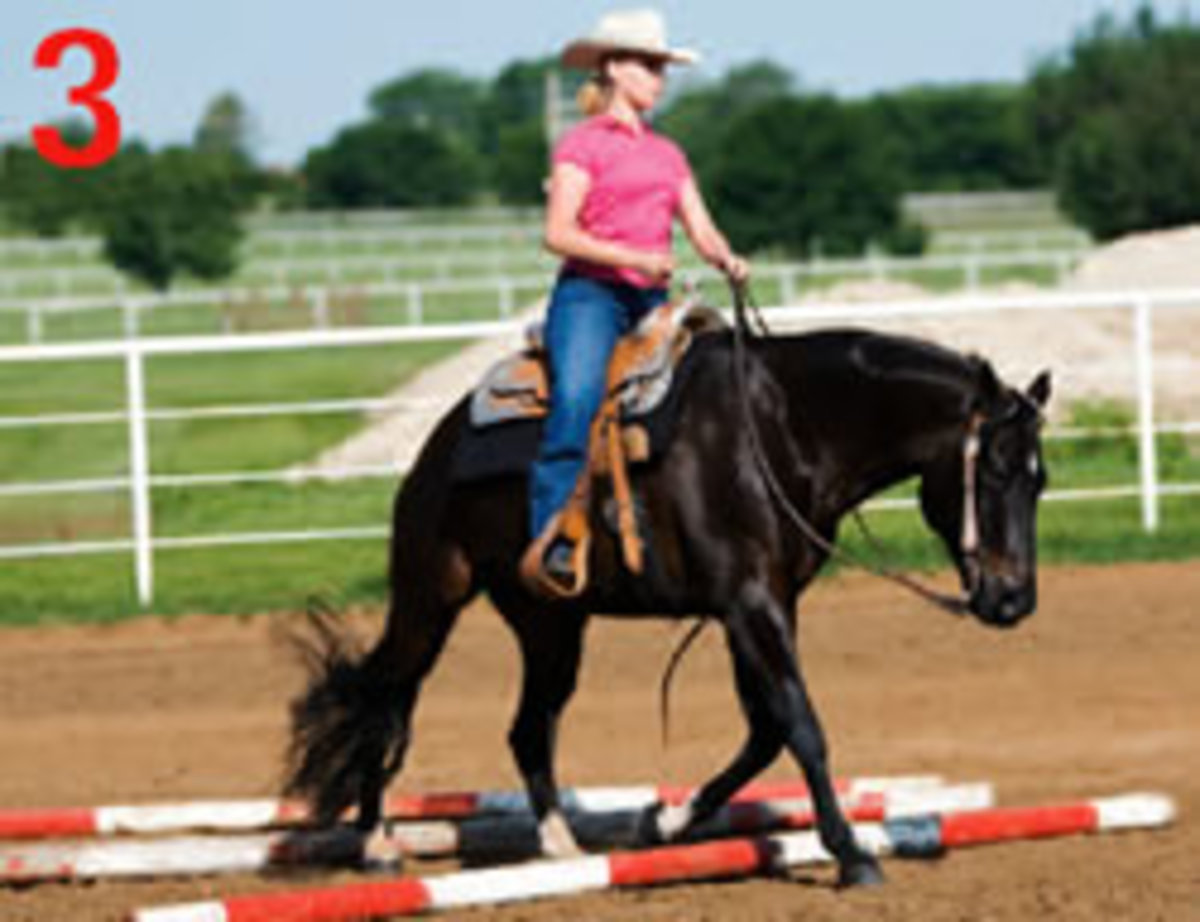
“Continuing on Path A for the shortstrided horse, make a slightly arced left turn, so you’ll guide Zippy to the center of the spoke’s poles (see the diagram for clarification). The path in between the first box and the spoke (for Path A) is 18 feet, indicating three strides before you reach the spoke, with one stride over each spoke. It may be tempting to look down at the spoke’s poles, but maintain a forward focus, looking slightly left for your final obstacle, Box #2. And, again, don’t rush (or slow) Zippy through the spoke. It may take him several tries, but he’ll figure out how to make adjustments with his stride to navigate the obstacle smoothly. Too much interference from you may actually hinder his performance.
“If you’re riding a long-strided horse along Path B, you’ll be making a wider left arcing turn between Box #1 and the spoke. On this path there are approximately 19 to 20 feet in between the box and the spoke, but it still equals three strides, as each stride for this horse is slightly longer than those following Path A. From here, you’ll aim for the path slightly right of center over the
spoke’s poles, which has a little more space between each pole. Again, each spoke pole will be one stride–this route simply gives a longer-strided horse an easier path for his natural stride length.”
4A. & 4B. BOX #2
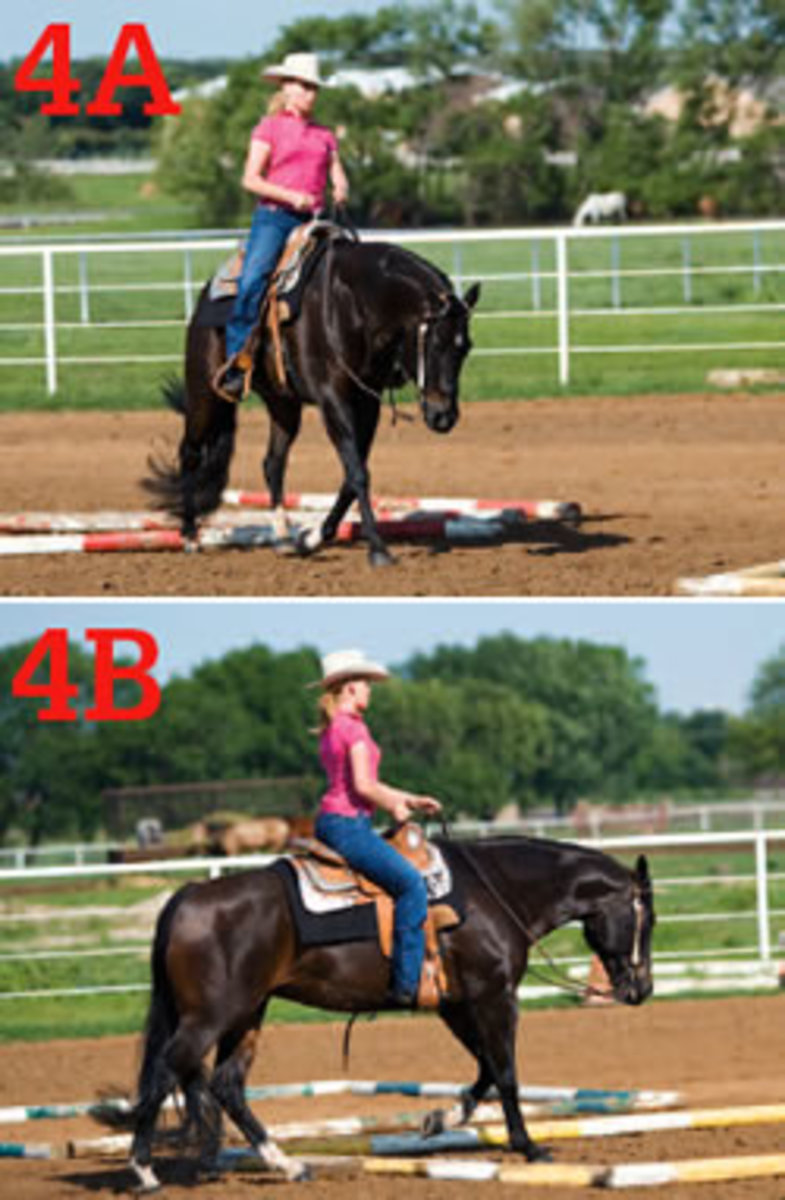
“As you’ll see in the photos, the second box is composed of the yellow and white poles (again, this should be a 12-foot box like Box #1). The distance between the spoke and Box #2 for Path A is 18 feet again–equivalent to three strides for Zippy (photo 4A and 4B show Path A from the spoke to Box #2). If you’re on Path B, your distance between the two will again be 19 to 20 feet, also three strides.
“On Path A, aim for the center of the box; Path B horses should aim slightly right of center. For both the box will again be done in two strides. Path B riders may need to shorten their horse’s step slightly to make two strides work smoothly.”
Keep in mind
“You and Zippy aren’t going to do this perfectly on the first try. You’re learning ‘how’ to feel his stride, and he’s figuring out how to negotiate distances between poles. Drill yourself through this course several times, until you feel like you’ve had a good runthrough. Then, reward Zippy by taking a break and allowing him to relax, and then go through the course again. You can also switch directions and do this course from the right lead–it’s always a good idea to work both sides evenly, especially on this exercise because some horses like one particular lead over the other. After practicing this enough, you’ll feel more confident in knowing Zippy’s stride length, and ultimately improve your overall trail performance.”
Team Horse & Rider member Charlie Cole has been involved with horses for over 20 years and has trained more than 50 world champions in the AQHA. Charlie and Jason Martin, are four-time winners of the AQHA Superhorse award and four-time winners of the APHA World Show All Around Horse. He owns the stallion, Artful Investment, a five-time AQHA world champion who has earned more points than any other stallion in AQHA history. He and Jason own and operate Highpoint Performance Horses in Pilot Point, Texas.
This article originally appeared in the July 2006 issue of Horse & Rider magazine.







